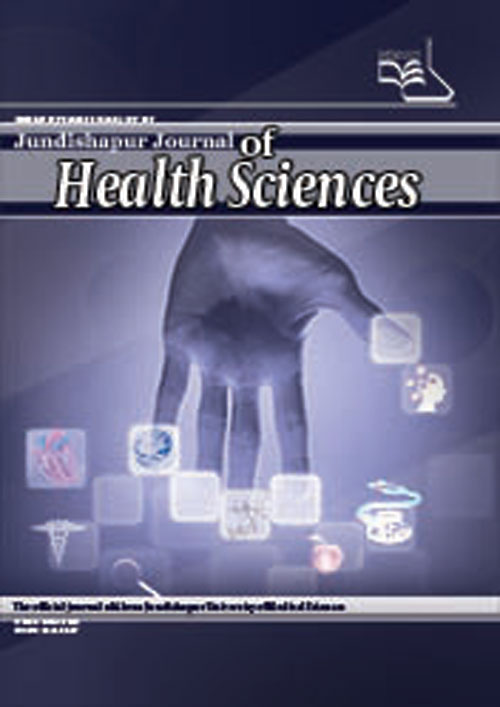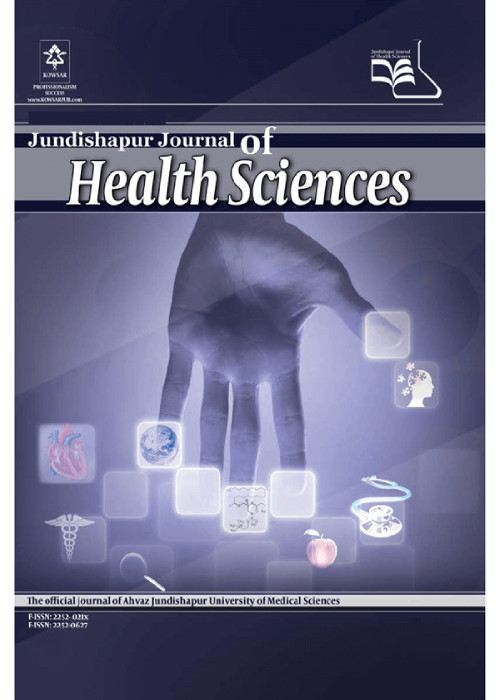فهرست مطالب

Jundishapur Journal of Health Sciences
Volume:9 Issue: 3, Jul 2017
- تاریخ انتشار: 1396/07/22
- تعداد عناوین: 8
-
-
Page 1BackgroundThe health implication of exposure to gamma radiation in the outdoor and indoor environments has become a major concern worldwide.MethodsThis study was conducted in the city of Birjand where three stations and buildings were randomly selected to measure the background radiation in outdoor and indoor places; for this purpose, GM detector (X5C plus) was used. All dose rates on the display of the survey meter were recorded, and the mean of all data in each station and buildings was computed and taken as the measured dose rate of that particular station.ResultsThe average dose rate of background radiation was 71.8 nSv/h for outdoor and 82.0 nSv/h for indoor environments, and the maximum and minimum dose rates were 79.6 nSv/h and 61.7 nSv/h for outdoor measurements and 112.9 nSv/h and 70.8 nSv/h for indoor measurements, respectively.ConclusionsThe results revealed that the annual effective dose is 0.49 mSv, which is similar to that of the global level (0.48 mSv). The estimated excess lifetime cancer risk was 1.715 × 10-3, which was high compared to the world average value of 0.25 × 10-3.Keywords: Gamma Radiation, Indoor, Outdoor Environment, Dose Rate, Annual Effective Dose, Excess Lifetime Cancer Risk
-
Page 2BackgroundAnnual large amounts of wastewater can be entered into the environment from domestic, agricultural, and industrial sources that contain high concentrations of chemical materials and heavy metals. Chromium (Cr) is one of the most important environmental pollutants, which can cause pollution of water resources and disorder in the metabolic activities of living organisms.ObjectivesIn this study, we used the alteration in the concrete structure by iron oxide nanoparticles and rice husk ash (RHA) to remove Cr as a heavy metal from sewage.MethodsRice husk ash was used in the structure of concrete as a forty percent by cement weight. Samples were made according to sewage condition and concrete required strength of purification pools. Sample's surface was covered with nanoparticle, RHA, RHA and nanoparticle. Different sewage concentrations of Cr were made from the range of 1 to 1000 ppm. The effects of parameters, such as contact time, adsorbent dose, pH, concentration of Cr in sewage, and Cr absorption were examined.ResultsThe maximum absorption was obtained 99.7%, in the contact time of 6 hours, dose of adsorbent 20 mg/L, pH 3, and Cr concentration in sewage 10 ppm at the laboratory temperature. Cr absorption followed the Freundlich model of adsorption.ConclusionsThe combination of nanoparticles and RHA showed well efficiency for Cr absorption from sewage.Keywords: Concrete, Iron Oxide Nanoparticles, Surface Adsorbent, Rice Husk Ash, Chromium (+6)
-
Page 3BackgroundMarriage is a social process that forms the basis and principle of human communication. In many couples, primary positive feelings decrease in time and are replaced by severe conflicts. What is of high importance is the couples reaction to these problems. Their ability to apply problem- solving skills can be a factor in the improvement of the couples relationship.MethodsA quasi-experimental study with pretest, posttest design and control group was applied. The statistical population included all conflicted couples referring to consultation centers in the city of Isfahan in 2016. The subjects were recruited in voluntary form. The experimental groups included a group of cognitive-behavioral couple therapy (CBCT) (15 couples) and another group of acceptance and commitment couple therapy (ACT) (15 couples). Both groups received 12 ninety-minute sessions of therapy once a week. 15 couples were put into the control group. The study instruments were a questionnaire on demographic features and Barati and Sanaies questionnaire of marital conflicts. In order to analyze the data, besides descriptive statistical methods, COVARIANCE analysis was used in SPSS.ResultsThe results revealed that cognitive-behavioral couple therapy and acceptance and commitment couple therapy made significant changes in conflict decrease at the posttest stage (P 0.05).ConclusionsAccording to the results, cognitive-behavioral couple therapy and acceptance and commitment couple therapy made significant changes in conflict decrease at the posttest stage and there was no significant difference between the effects of these two therapeutic methods at the posttest stage. Therefore, the present study provides experimental support for both therapies in order to decrease the marital conflicts.Keywords: Conflict, Cognitive, Behavioral Couple Therapy, Acceptance, Commitment Couple Therapy
-
Page 4BackgroundMost addicts relapse in the first year of treatment especially in the first 3 - 6 months, which is the most vulnerable period.ObjectivesThe present study aimed to assess the predictors of substance abuse slip and relapse among addicts in the first 6 months of treatment with an emphasis on treatment related factors.MethodsThe data of this cross-sectional study collected through assessment of 148 patients who were referred to the Methadone/Buprenorphine maintenance therapy clinics of Kermanshah city during April to September of 2015. Demographic, history, treatment checklist, comorbidity index, and medical records were used for collecting data. Data was analyzed through chi-square, t-test, and Binary logistic regression analysis.ResultsThe mean age of total participants was 42.4 ± 11.3 years and 98% of them were male. 27% and 35.1% of the patients, respectively, had a slip and relapse during the first 6 months of treatment. After adjustment for all demographic data, it was indicated that self-employment (P = 0.037), more treatment costs (P = 0.049), previous treatment history (P = 0.027), not satisfied dose of medication (P = 0.012), and lack of medical therapy history under physicians supervision (P = 0.046) can increase the possibility of a slip significantly.ConclusionsDespite the fact that prevention of re-abuse and relapse of disease includes multi-factorial approach, it seems that the treatment-related factors are as the most major factors in relapse and slip during the first 6 months of treatment. Health practitioners special attention to treatment related factors in addiction, especially previous treatment history as the most important predictor of relapse, are probably effective in the control and decrease of a slip and relapse.Keywords: Drug Dependence, Treatment, Substance Abuse Treatment Centers
-
Page 5BackgroundRice is the second highly consumed foodstuff among Iranian people. However, high levels of cadmium (Cd) are reported in some paddy fields in Khuzestan province, Iran.ObjectivesThe current study aimed at investigating the Cd concentration in rice grains by the decision tree using J48 algorithm. The current study also used WEKA software to implement the algorithm.MethodsA total of 630 samples (9 attributes in 70 sampling areas) were taken from each paddy field (5 regions); hence, seed and soil samples were analyzed according to the standard laboratory procedures and finally, the data mining technique was used for the classification of trees by J48 algorithm to predict the concentration of Cd in rice seed.ResultsThe results showed that the average concentrations of Cd in rice seed and soil were 81.4 and 273.6 μg/kg, respectively; it was also shown that J48 gives 95.71% accuracy, 0.899 Kappa coefficient, and less error (RMSE = 0.179), which make a good predictive model. A significant correlation was observed between soil characteristics and the concentration of Cd in rice seeds.ConclusionsThe data mining technology can be used to predicate Cd concentration in rice seeds, and also J48 algorithm is a simple designer to construct a decision tree; nevertheless, offers good results in experiments.Keywords: Rice, Data Mining, Cadmium, J48
-
Page 6BackgroundMany kinds of inorganic polymers have been developed, but, amongst them, polyaluminum chloride (PACl) is one of the most common kinds and has become most widely applied.ObjectivesThe main objective in this research was the evaluation of three coagulants efficiency in the turbidity removal of Karoun river water in water treatment plant (WTP) of Kut-e Amir in different turbidity ranges of 0 to > 20000 NTU.MethodsFor evaluation of the three coagulants efficiency (including polyaluminum chloride (PACL), aluminum sulfate (Alum) and ferric chloride) a jar-test was done for every turbidity range. In this research, coagulant aid (Besfloc) was added when samples turbidity were > 300 NTU. Turbidity of samples were measured by the turbidity meter with the model of HACH2100N.ResultsAccording to the results, it was clear that PACL and Ferric Chloride had the better results in turbidity removal in comparison with Alum. Considering Ferric Chloride is cheaper than PACL and Alum, WTPs prefer to use Ferric Chloride. Economic analysis in WTP of Kut-e Amir showed that using Ferric Chloride achieved less costs in comparison with PACL and Alum.ConclusionsConsidering close and suitable results of Ferric Chloride and PACL in turbidity removal and more economical efficiency of ferric chloride than PACL, its recommended to be used from ferric chloride with Besfloc when turbidity is under 6500 NTU. In the end, injection of coagulants different doses did not vary pH samples significantly.Keywords: PACL, Alum, Ferric Chloride, Turbidity Removal
-
Page 7BackgroundAnthropometry is a very accurate tool in ergonomic design process; the design of appropriate rehabilitation equipment based on anthropometric data results in disabled empowerment, decreased health expenses, and allows disabled individuals to live and act in the society like other healthy citizens. The purpose of this study was to determine anthropometric dimensions of disabled male and female cases (wheelchair users) and compare this with healthy individuals.MethodsThis analytic-descriptive study was performed during year 2012 in Tehran city. The sample population consisted of 314 disabled and healthy individuals, including 150 healthy and 79 disabled males and 50 healthy and 35 disabled females. The age range of samples was 25 to 55 years old. Disabled individuals were manual wheelchair paraplegic users while healthy participants were official staff. The simple probability sampling method was used. In this research, 9 (9) anthropometric dimensions, applied for designing wheelchair and seats, were measured.ResultsThis research showed that the average sitting height was 78.4 ± 6.75 cm among disabled males and 58.47 ± 4.5 cm among disabled females. Also, the sitting height was 90.97 ± 3.55 among healthy males and 83.72 ± 4.54 among healthy females. Comparison between healthy and disabled male and female subjects showed that 6 out of 9 dimensions had a significant difference between them PConclusionsThe results indicate significant differences among healthy and disabled individuals in anthropometric dimensions and the highest difference was found in the height dimension and access limits.Keywords: Ergonomics, Anthropometry, Disabled People
-
Page 8BackgroundHypertension is an important public health problem, which is prevalent and asymptomatic, with modifiable and preventable risk factors. Afghanistan is suffering from double burden of diseases including communicable and noncommunicable diseases (NCDs). The present study aimed at identifying hypertension and determining its factors among the adult population in city of Kandahar in Afghanistan.MethodsThis cross- sectional study was conducted using WHO STEPwise tool, a WHO standardized tool for risk factors of (NCDs) in urban locality, in city of Kandahar during October and November 2015. The study used a random sample of 1165 adults aged 25 to 70 years. Data were collected using a structured questionnaire for assessing noncommunicable diseases and their risk factors. Fasting venous blood samples were collected to assess the lipid profile and fasting blood sugar. Anthropometric measurements of the participants were also taken. Data were analyzed using SPSS Version 20.ResultsOut of all respondents, 597 (51.2%) were females and 568 (48.8%) were males, with a mean age of 38.3 ± 11.2 years. Around two thirds of the participants (73.2%) were illiterate, 9.7% smokers, and 16.3% mouth snuff users. Of the respondents, 60% consumed fruits 3 days or less than a week and 60% consumed vegetables more than 3 days per week. Moreover, almost 6% of the respondents practiced vigorous physical activity and 21.3% reported doing moderate physical activity, and one third (32.2%) of the respondents had high blood pressure. The results of multivariate analysis revealed that the independent risk factors associated with hypertension were age, gender, education status, high body mass index, central obesity, and physical inactivity with respect to reclining hours per day.ConclusionsOne third of the adult population in the urban setting of Kandahar is suffering from hypertension. Thus, it is highly recommended to focus on interventions to prevent and control noncommunicable diseases.Keywords: Hypertension, Risk Factors, Blood Pressure, Prevalence, Afghanistan


